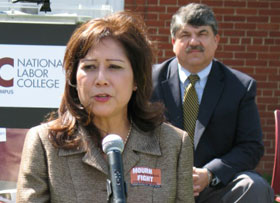 The Bureau of Labor Statistics issued its 2011 Union Members Survey late last week calling the percentage of unionized workers “essentially unchanged” from 2010 to 2011. 11.8% of the American workforce was unionizing in 2011, a new post-WWII low, down slightly from 11.9% in 2010. The bureau reports 14.8 million union members in 2011 with another 1.5 million working under union contracts as non-members. Public sector workers were more than five times more likely to be unionized than private sector workers (37% and 6.9% respectively). The report showed a loss of 61,000 public sector unionized jobs (due to local and state government cutbacks) while unions picked up 110,000 dues payers in the private sector. Unions gained the most in construction, healthcare, retail, metal production, hospitals and transportation. The overall percentage fell slightly because the economy added jobs. That 0.3% swelling of the union ranks was cause enough for AFL-CIO honcho Richard Trumka to celebrate. “Good union jobs are beginning to come back despite an unprecedented volley of partisan political attacks on workers’ rights and the continuing insecurity of our economic crisis.” (At roughly $300 a year in dues revenue from each of the 50,000 newly unionized workers gained last year it will take organized labor about 26 years to recoup the $400M it spent in hard money alone electing Obama in 2008, not to mention his Congressional enablers.) However Labor Secretary and Head Union Cheerleader Hilda Solis saw the figures a little differently. “Today the Bureau of Labor Statistics announced that, in 2011, the unionization rate of employed wage and salary workers was 11.8 percent, essentially unchanged from 11.9 percent in 2010. Among private sector employees, the rate remained at 6.9 percent. Ensuring that all people have a voice at work and protecting their right to organize and bargain collectively are essential for an America that’s built to last, where everyone gets a fair shot, everyone pays his or her fair share and everyone plays by the same rules.” The Heritage Foundation, as one might expect, took something else entirely away from the numbers. “Union membership has fallen because traditional collective bargaining does not appeal to most workers. Polls show that only one in 10 non-union workers wants to organize. This makes sense: In the competitive private sector, unions can do little to raise their members’ pay. Additionally, most workers like their jobs and believe they are on the same side as their employers. But while workers reject unions, they do want a voice in the workplace. Unfortunately, the NLRA prohibits employee–employer working groups that give employees that voice. It is time for Congress to allow non-union employers and employees to work together to improve working conditions.” Amen.
The Bureau of Labor Statistics issued its 2011 Union Members Survey late last week calling the percentage of unionized workers “essentially unchanged” from 2010 to 2011. 11.8% of the American workforce was unionizing in 2011, a new post-WWII low, down slightly from 11.9% in 2010. The bureau reports 14.8 million union members in 2011 with another 1.5 million working under union contracts as non-members. Public sector workers were more than five times more likely to be unionized than private sector workers (37% and 6.9% respectively). The report showed a loss of 61,000 public sector unionized jobs (due to local and state government cutbacks) while unions picked up 110,000 dues payers in the private sector. Unions gained the most in construction, healthcare, retail, metal production, hospitals and transportation. The overall percentage fell slightly because the economy added jobs. That 0.3% swelling of the union ranks was cause enough for AFL-CIO honcho Richard Trumka to celebrate. “Good union jobs are beginning to come back despite an unprecedented volley of partisan political attacks on workers’ rights and the continuing insecurity of our economic crisis.” (At roughly $300 a year in dues revenue from each of the 50,000 newly unionized workers gained last year it will take organized labor about 26 years to recoup the $400M it spent in hard money alone electing Obama in 2008, not to mention his Congressional enablers.) However Labor Secretary and Head Union Cheerleader Hilda Solis saw the figures a little differently. “Today the Bureau of Labor Statistics announced that, in 2011, the unionization rate of employed wage and salary workers was 11.8 percent, essentially unchanged from 11.9 percent in 2010. Among private sector employees, the rate remained at 6.9 percent. Ensuring that all people have a voice at work and protecting their right to organize and bargain collectively are essential for an America that’s built to last, where everyone gets a fair shot, everyone pays his or her fair share and everyone plays by the same rules.” The Heritage Foundation, as one might expect, took something else entirely away from the numbers. “Union membership has fallen because traditional collective bargaining does not appeal to most workers. Polls show that only one in 10 non-union workers wants to organize. This makes sense: In the competitive private sector, unions can do little to raise their members’ pay. Additionally, most workers like their jobs and believe they are on the same side as their employers. But while workers reject unions, they do want a voice in the workplace. Unfortunately, the NLRA prohibits employee–employer working groups that give employees that voice. It is time for Congress to allow non-union employers and employees to work together to improve working conditions.” Amen.




